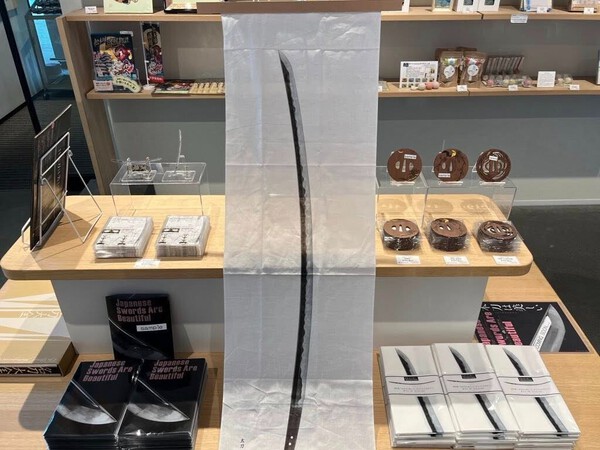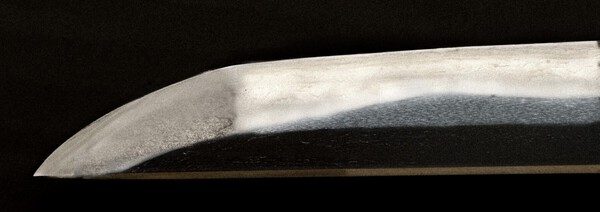-
Posts
2,280 -
Joined
-
Last visited
-
Days Won
19
Content Type
Profiles
Forums
Events
Store
Downloads
Gallery
Everything posted by Rivkin
-

Mumei Katana info request, age, school and nakago ID
Rivkin replied to Fathergascan's topic in Nihonto
Probably Kaga (nakago, suguha) and I would guess later Muromachi one. -

Thoughts and Attributions on an O-Suriage'd Wakizashi
Rivkin replied to Marcus Devonport's topic in Nihonto
By the way a very good example: https://www.facebook.com/permalink.php?story_fbid=pfbid0DuWnGr4pt2ChaYLf78neA1GxvTSRSijfmk8X9AxF8ZvWstPJS5DRM6k3U4em7Cipl&id=100064812335888 Classic late groupings, but top mainline Sukesada work predictably shows much stronger nie. Midare utsuri though very seldom encountered past 1500. It still feels in regards to the mumei blade shown the very well defined, uniform groupings might be suggestive of later than Oei attribution. I don't think its as late as Sukesada or Kiyomitsu, but it might be post Oei generation. -

A parting gift from a friend.
Rivkin replied to obiwanknabbe's topic in General Nihonto Related Discussion
Hard to be sure. Sugata can be anything, but its not kodachi and then 22-24 inch blades generally would not be earlier than Muromachi. Hamon starts flat. Uncommon for Muromachi. Relatively dense jigane, but with some coloration. Very strong, harsh patchy nie. Generally in Soshu-Hitatsura you see strong nie during early Muromachi and then again during the Edo period. The writing with distinctive, deep triangular strikes, its more late than early in style, irrespective of whether its gimei or not. If its early Muromachi it does not look like Masahiro or related Soshu, long nie lines are like Uda. But Uda usually does not go into hitatsura. I would lean towards Edo period. -
Again my apologies for misdirection. I am at fault for not even looking at the original signature besides its overall style. After investing quite some time in AI tools (diffusion based photo enhancer, kantei tool, and chatgpt sdk auto-translate) I had very good success with them for a while... and then ofcoarse they fail miserably without warning. Another challenge of our days, but first and foremost definitely my fault.
-
Thank you very much! And I should not hope chatgpt does the work for me.... I've been running it on auto-translate for the images for a while though....
-
Double post... I would say though with Muromachi Bizen its important to show entire nakago since there are quite a few clues to whether its original or not.
-
Signatures of this level ChatGPT translates with 90% accuracy. Bishu Osafune ju Sukesada. Its a lower grade signature which is somewhat roughly executed, but can be real and the blade sort of looks like late Muromachi. P.S. Chatgpt more often than not does good job on papers, sayagaki and books as well.
-

What makes a sword a masterpiece?
Rivkin replied to Hoshi's topic in General Nihonto Related Discussion
This sword has provenance, gold inlayed nijimei "Mitsutada", has been published in at least one book; probably more, but there was only one I could find right away by searching for "Osafune Mitsutada". Its polishing has been sponsored by Japanese government, the whole process has been covered in the journal of Nara Museum of Buddhist Art. Meito? Masterpiece? -
Can't fool me. Its chikei.
-

Thoughts and Attributions on an O-Suriage'd Wakizashi
Rivkin replied to Marcus Devonport's topic in Nihonto
I would say as common as midare utsuri. They go well together, while indeed mokume is quite common, but utsuri will typically be more simple. On Mino... I can finance the sword going to NBTHK for shinsa and I'll put 5,000 USD as wager. If it gets Bizen to one of Muromachi generations (simply because I can't guarantee they'll put a specific generation or period on the papers, its a bit random), I win 5,000$. If it gets Mino I lose 5000$ wager. If it gets neither I do not get compensated for the shinsa. -
I would prefer higher res photo to see whats hadori and whats not, otherwise it might end up being Ichimonji or something [embarassing]. But it does have considerable "Go feel". I did not study many of his blades but there is this reocurring type widening above nakago, widening next to kissaki, ichimai. Exhibit is in matsumoto, probably Japanese based members know more, it has some nice items.
-
Looks like a particularly nice one... They have some sexy plastic sword stands for sale for the exhibit as well...
-

Shinshinto- Gendaito periods inaccurate?
Rivkin replied to jdawg221's topic in General Nihonto Related Discussion
There are conflicting opinions about recent work since after 1980s the economy of swordmaking has been slowly declining. But they are better. Early Showa is not impressive outside of a few names. Actually for better or worse post 1960 works tend to be really similar to shinshinto in stylistics. A bit artificial, harsh, strong lined, but bright and rich. -

Shinshinto- Gendaito periods inaccurate?
Rivkin replied to jdawg221's topic in General Nihonto Related Discussion
Very few only smiths who can be seen as extension of shinshinto, for example Gassan. The rest started anew with random steels and strange styles, only in late 1930s you start having Shibata Ka and other smiths who to an extent restore the tradition. Still, until 1970-1980s probably the quality was two grades below shinshinto. -

What happens to collectons?
Rivkin replied to Peter Bleed's topic in General Nihonto Related Discussion
Should I pay attention to this? Everytime I think about it, the answer is "I don't know". Alien society and people, alien manners... who am I to judge? Observed ill intent or impropriety might exist only in the reflection of our self-absorption. Certainly, few today understand what swords really signify. Born in a society which believes the history ended in 1945, the "history" being kind of unenlightened insanity, at best accepted through preservation. The best recent deathbed treatment given to a sword was by Mishima. Strange, out of place, "pointless", yet undeniably beautiful and in many ways proper for the sword, proper for the smith. Like Kondo Isami honoring Kotetsu, anyone using an old blade, or any blade at all should consider the responsibility. If he is a warrior whose fame will endure for centuries, fire burial with a beloved blade is proper and will honor the blade and the smith. If one is to slaughter hundred enemies, it honors both the blade and the smith. Use the old blades. Make your deeds worthy. -

What happens to collectons?
Rivkin replied to Peter Bleed's topic in General Nihonto Related Discussion
Who knows if a sword, or its previous owner, prefers the thing stored in a safe or dying while doing what it was created to do. I don't. But I would certainly prefer to be killed by a quality blade rather than an ugly mass produced crap covered with machine oil. Unless its important historically... It has importance as a link of warrior cultures, past and present. And I heard you are not supposed to own mumei shinto and shinshinto anyway. -

What happens to collectons?
Rivkin replied to Peter Bleed's topic in General Nihonto Related Discussion
If the blade has limited cultural or artistic value... Wotanists/Valhallists do burn bodies with swords and other weapons. Conversely when fighting or decapitating someone, it is proper to use an even better weapon, in the very least to show respect. Would not use koto for either of these purposes, but a shinto blade, why not. We will all die, and so will all the swords. Naturally they will much later than us, but then to go off in battle is a great honor. -

Thoughts and Attributions on an O-Suriage'd Wakizashi
Rivkin replied to Marcus Devonport's topic in Nihonto
He was not particularly known for bo utsuri, it sort of overall Muromachi trait, somebody copied from some book. Its all hair splitting since they are very similar, but with Oei Morimitsu and alike you don't expect groups of the same height, 4 elements+. You expect large choji-gunome joined with a few others, quite a bit more non-uniform appearance. Strong groupings with flat hight/similar width are associated with Eikyo-Onin-Bunmei pieces. But they very seldom have midare utsuri shooting to shinogi and ashi tend to start closer to the edge, overall hamon can be narrower on average. Sanemitsu did flat height large grouping with very wide and expressive hamon, with some ko nie sprinkled around the hamon's upper portion. Its a good match. -

Thoughts and Attributions on an O-Suriage'd Wakizashi
Rivkin replied to Marcus Devonport's topic in Nihonto
The most likely bet is Oei Bizen Sanemitsu. -

Thoughts and Attributions on an O-Suriage'd Wakizashi
Rivkin replied to Marcus Devonport's topic in Nihonto
It is excellent. It can be many things, but my feeling this is Oei to Bunmei Bizen. It kind of wants to be Saburo, but the groupings are too distinct, sort of Muromachi broad boshi... But this is great. -
Most Go that I've seen that "widened" hamon, noticably did so within 10 inches below kissaki. The width variation exists, though noticably less pronounced compared to say Kaneuji, and it occurs differently compared to other schools - with particularly long "wide" areas. Hope this helps.
-
Not the image I am particularly proud of, but shows the general gist. AOI's Tametsugu definitely has this Go widening and Ichimai, but very tired, jigane is gone, nie is rough... But a very rare type of "Tametsugu" with Go features, indeed.
-
It is sort of Soshu, but first and foremost what is Ichimai boshi and what is "attributed" are not perfectly defined terms. In textbook pictures you see fully and uniformly hardened kissaki with nioi-guchi located outside yokote. This is rare. And if you see Go where hamon starts to widen before kissaki and then the entire kissaki is hardened - its ichimai, and the papers typically say simply "Go". Sayagai might say "kiwame Go". Then there are pieces where it widens or not before the kissaki, but within the kissaki the hamon is simply very wide, nie+nioiguchi covers 85% of kissaki area, but there is certainly some "empty space" left out. Then the papers might as well say "Den Go". The percentage of Ichimai boshi for Go strongly depends on whether you include "Den Go". But then a dealer also can describe the wide hamon as ichimai, it happens all the time.









.thumb.jpg.37bd9c646ee0a2b48e4385b15e095ee4.jpg)
